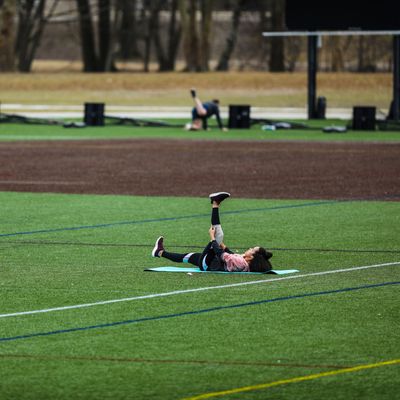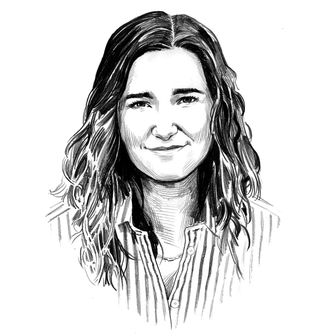
The other night, I went to see a movie with a friend. It wasn’t my first time back in a movie theater since the pandemic began, but the last two times I went, I wore a mask throughout, lowering it only occasionally to quickly eat a handful of popcorn. Masks are no longer required at most businesses, though, so I was free to watch Channing Tatum and Sandra Bullock onscreen for two hours, breathing into the air around me. With everyone else in the theater. Which was actually kind of crowded. Which is why, more than halfway through the movie, I found myself putting my KN95 mask back on. I knew it was far too late for that mask to be effective, but I put it on anyway, because I was anxious.
Though the pandemic is not yet over, conditions have markedly improved since 2020, and most people have changed behaviors accordingly. But a recent study for the National Bureau of Economic Research suggests not everyone plans to resume their pre-COVID lives: When asked “Once the COVID-19 pandemic has ended, which of the following would best fit your views on social distancing,” about 13 percent of people said they planned “no return to pre-COVID activities.” (The other options were “complete return,” “substantial return,” and “partial return.”) One of the study’s authors, Nicholas Bloom, a professor of economics at Stanford, referred to this phenomenon in the New York Times as “long social distancing.”
Of course, it’s hard to know what the world will look like when (or if) COVID has “ended,” and all we can do now is speculate. But the researchers have asked a version of this question every month since the pandemic began, and the number of people who say they have no plans to stop social distancing has remained relatively unchanged (between 10 to 15 percent) despite vaccination and other encouraging metrics. “The most surprising thing is how persistent that group seems,” says the study’s lead researcher, Jose Maria Barrero, an assistant professor of finance at Instituto Tecnológico Autónomo de México (ITAM). The study saw more substantial variation between its other three categories (i.e., people switching from “partial” to “substantial” or “substantial” to “complete”) as relative risk decreased, but for whatever reason, that slice of “no return” respondents has held fast.
Ten to 15 percent is a sizable minority — that amounts to between 25 million and 38 million adults in the U.S. And while that group may shrink, it hasn’t yet, and so it seems important to ask why: If one’s risk of contracting or transmitting COVID is negligible — as the survey asks respondents to envision — why wouldn’t they do all the things they did before?
For his part, Barrero theorizes that generalized anxiety is a not-insignificant part of it. “There are a bunch of respondents who say that fears of infection or preference for remote work are actively informing their decision to search for remote jobs,” he says. “To me that’s an indication that infection fears are on people’s minds. More than risk, I think that speaks to anxiety.”
For older and immunocompromised groups, the risk of contracting COVID (and experiencing resulting complications) remains more severe, and it follows that they’d exercise more caution. Approximately 3 percent of Americans qualify as immunocompromised, and a much higher number have conditions (like asthma, COPD, diabetes, etc.) that put them at greater risk of severe illness. Still, neither the study’s authors nor mental-health experts think those with elevated risks and the long social distancers are a perfect overlap; some otherwise healthy adults are just plain anxious.
“I do think we’ve seen an uptick in social anxiety and health anxiety as a result of the pandemic,” says Thea Gallagher, an assistant psychiatry professor at NYU Langone Health. “I think if people are saying, ‘I’m going to make my life smaller and do my best to avoid getting sick at all costs, or do my best to avoid situations that make me slightly uncomfortable,’ that could be concerning in the long haul.” While COVID certainly isn’t “over,” and the risk is by no means imagined, Gallagher encourages would-be “long social distancers” to ask themselves why they don’t want to resume certain activities. Health anxiety and social anxiety have become, for many, inextricably linked; much of what we’ve been asked to do these past two years is stay away from each other. For people already predisposed to generalized (or social) anxiety, it may be difficult to untangle fear of infection from fear of the outer world more broadly.
“What happens with anxiety is that once you stop doing things, it begets more avoidance, and then it begins to spread,” she says. “If you start avoiding small things, it can turn into bigger things, and all of a sudden you’re in therapy with me because you can’t leave the house.” (Like other experts, Gallagher says she’s seen an uptick in patients dealing with agoraphobia since 2020.)
A 46-year-old woman living with an anxiety disorder in Washington, D.C., told me she would have been a “total recluse” if not for her husband and child, who has special needs. Earlier in the pandemic, she avoided going anywhere, even masked — but “seeing my husband and son do what I was worried about and be okay was like exposure therapy,” she says. “Seeing how happy my son was when school started again — and knowing he’d be surrounded by other kids — I felt like we were all going to be okay.”
Elinor Bock, the founder and director of Therapists of New York, says it’s also important to acknowledge that the shift back to “normalcy” has felt sudden for many people, and it’s understandable that many people have been left reeling. “My sense is that this has all moved very fast for people,” she explains. “It’s not a light switch where now there’s danger, now there’s not. I think there’s some subset of people that are just afraid — not because of COVID, but afraid of the change, afraid of reentering society.”
In cases where there is lingering hesitation to resume pre-COVID activities, Bock says she hopes to see people interrogate the reasoning behind their decisions. “The way I view humans is as social creatures, so I do think it’s odd when people want to be in isolation, but so many people have had histories that don’t lend themselves to wanting to be around people,” she says. “I would hope that they would be able to talk through that with themselves at least, or to have some support, and to own it. I guess the question is if their well-being is better for it or not.”
A 32-year-old woman with illness anxiety (the preferred term for hypochondria) told me she was grateful to have been in therapy prior to the pandemic. As a result, she doesn’t think her shifting priorities — to stick with things she likes, like ax throwing once a week, and skip those she doesn’t, like internet dating — are based in fear.
“I don’t feel like the changes I’m making in my life are based in anxiety around contagion and social settings,” she says. “I feel like I’ve had the opportunity to realize that I don’t like being around big groups of people. That’s a common thread among my friends.”
Bock says she expects we will all feel the lasting impact of this pandemic; it’s just a question of how, and to what extent. “I knew someone’s grandpa who, because he was in the Great Depression, would leave a little bit of OJ that was left in his cup in the fridge, because he didn’t throw anything away,” she says. “My guess is we’re going to have behaviors like that.”
When the pandemic began, there were a number of stories about people with anxiety feeling strangely prepared for the chaos they’d spent years worrying about. As risk-mediating regulations are lifted and uncertainty follows, the chronically anxious are likely to feel anxious again. Other people may be experiencing anxiety for the first time. “For a good number of people, I think there will be a memory of being this fearful for so long,” says Bock. “I think we’ll be seeing the repercussions of that for a while, and I think it will manifest in different ways for different people.”





